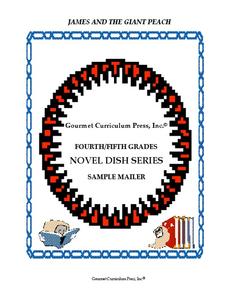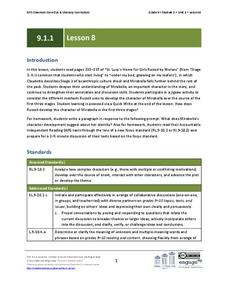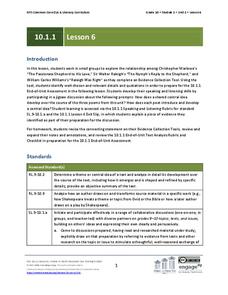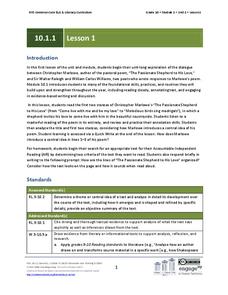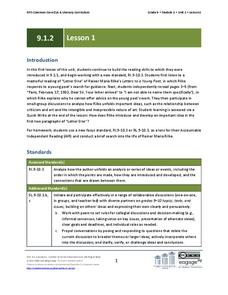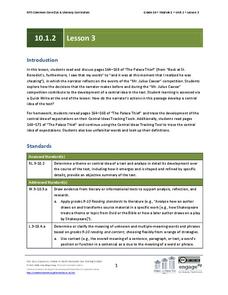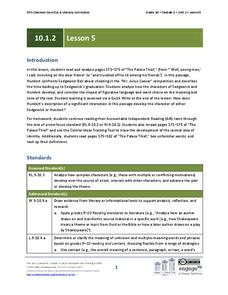Institute of Electrical and Electronics Engineers
Making Sense of Sensors
Have small groups in your class construct working hygrometers as an example of the benefits of using sensors in engineering. This activity can be used during a weather unit when covering humidity or in a STEM activity as a preparation...
Houghton Mifflin Harcourt
Write and Evaluate Algebraic Expressions
Once your math class is adept at writing expressions, challenge them with a few word problems! There are six real-world scenarios for which learners must come up with a representative variable expression. Take CCSS.Math.Content.6.EE.2.a...
Curated OER
Introduction to Cause and Effect
Teach your special education students about cause and effect with this SMART board activity. After analyzing real-life examples of cause and effect -'What happens when you eat too much? What happens when you don't get enough sleep?"-...
Pulitzer Center
"Voices from Haiti": Using Poetry to Speak up for a Cause
Explore a real world use of poetry with your class! Young language arts pupils consider the concept of advocacy and how journalism, photography, and poetry can raise awareness for a cause. They read several poems about individuals...
Northwest Career & Technical Academy Foundation
Working Together Digitally
Now that your kids know everything about the world around them, it's time to get them familiar with the importance of connecting and communicating with other people using digital technology. They engage in two different activities that...
Gourmet Curriculum Press
James and the Giant Peach
Here is a 19-page sample lesson that uses an interesting format. It starts with an appetizer or activity to make reading the book James and the Giant Peach fun. Then it dives into the main course or core content instruction which...
What So Proudly We Hail
The Meaning of America: National Identity and Why It Matters
Combining a close reading of a classic American text with the study of history can be a very powerful strategy, and this is most certainly the case with this resource using Edward Everett Hale's The Man without a Country. Consider themes...
Institute of Electrical and Electronics Engineers
Failure: Seeds of Innovation
"If at first you don't succeed, try, try again!" Through this assignment, emerging engineers examine how failed experiments are simply part of the process of an outstanding design. They begin with some reading about the microwave oven,...
Film Foundation
The Day The Earth Stood Still: The Filmmaking Process
How are films made? As part of their study of film, middle schoolers investigate the pre-production, production, and post-production process and consider the role of the director, the screenwriter, production designer, cinematographer,...
Film Foundation
The Day The Earth Stood Still: Film Language And Elements Of Style
In this, the third in a series of four resources that use Robert Wise's 1951 version of The Day The Earth Stood Still as the core text, young film makers examine the language of film including shot composition, camera angle, lighting,...
EngageNY
Grade 9 ELA Module 1, Unit 1, Lesson 7
A story about feral girls raised by werewolves will have some interesting character development! Track how the girls and their teachers act, speak, and change with a lesson focused on Karen Russell's "St. Lucy's Home for Girls Raised by...
EngageNY
Grade 9 ELA Module 1, Unit 1, Lesson 8
You can often track a character's development based on others' reactions to their words or actions. Using Karen Russell's "St. Lucy's Home for Girls Raised by Wolves," ninth graders work in a jigsaw activity to analyze how Mirabella's...
EngageNY
Grade 9 ELA Module 1, Unit 1, Lesson 1
Word choice can drastically alter the tone of a piece of writing. Ninth graders read Karen Russell's short story "St. Lucy's Home for Girls Raised by Wolves" and use textual evidence to help them analyze how word choice affects their...
EngageNY
Grade 10 ELA Module 1: Unit 1, Lesson 6
Wrap up your literary analysis unit with a discussion activity as tenth graders prepare for an end-of-unit assessment. After they have read and annotated Christopher Marlowe's "The Passionate Shepard to His Love," Sir Walter Raleigh's...
EngageNY
Grade 10 ELA Module 1: Unit 1, Lesson 1
Can authors speak to each other across works, genres, and centuries? Study the conversation between Christopher Marlowe in his poem "The Passionate Shepherd to His Love" and the responses by Sir Walter Raleigh and William Carlos Williams...
EngageNY
Grade 10 ELA Module 1: Unit 3, Lesson 1
The Joy Luck Club by Amy Tan is an illustrative source of rich prose, deep character development, and strong literary themes. Use two of the book's key chapters, which focus on Waverly's relationship with chess and with her mother, to...
EngageNY
Grade 10 ELA Module 1: Unit 3, Lesson 5
Even the most rigid expectations come from a place of deeply held values. In a key chapter of Amy Tan's The Joy Luck Club, explore the ways that Jing-Mei's mother's parental expectations affect her relationship with Jing-Mei. Tenth...
EngageNY
Grade 9 ELA Module 1, Unit 2, Lesson 1
Where does a writer find inspiration? "Go into yourself," says Rainer Maria Rilke in "Letter One" from Letters to a Young Poet. Readers of Rilke's letter to Franz Xaver Kappus examine the words and figurative language Rilke uses to...
EngageNY
Grade 10 ELA Module 1: Unit 2, Lesson 2
Class members continue their reading of Ethan Canin's "The Palace Thief," focusing on how the relationship between the narrator and Sedgewick changes after the narrator meets Sedgewick's father.
EngageNY
Grade 10 ELA Module 1: Unit 2, Lesson 3
Readers of "The Palace Thief" continue examining Ethan Canin’s short story and consider how the narrator's actions develop the central idea of how one's expectations and the expectations of others influence behavior.
EngageNY
Grade 10 ELA Module 1: Unit 2, Lesson 5
Readers of "The Palace Thief" focus on how the author's descriptions and word choices reveal the characters of the narrator, Sedgewick, and the senator.
EngageNY
Grade 10 ELA Module 1: Unit 2, Lesson 11
Is identity unchanging? Do events in our childhood forever influence our character? Groups ponder these questions as they examine Ethan Canin’s short story “The Palace Thief.”
EngageNY
Grade 10 ELA Module 1: Unit 2, Lesson 12
As the class concludes its close reading of “The Palace Thief,” groups consider how the narrator's character has changed throughout Ethan Canin’s short story.
EngageNY
Grade 10 ELA Module 1: Unit 2, Lesson 6
Is history "little more than a relic," as one of the characters in "The Palace Thief" contends? Has Hundert's love of antiquity kept him from changing with the times? Readers consider how the author uses these conflicting views to...
Other popular searches
- Common Core Standards
- Common Core State Standards
- Math Common Core Standards
- Science/common Core Standards





